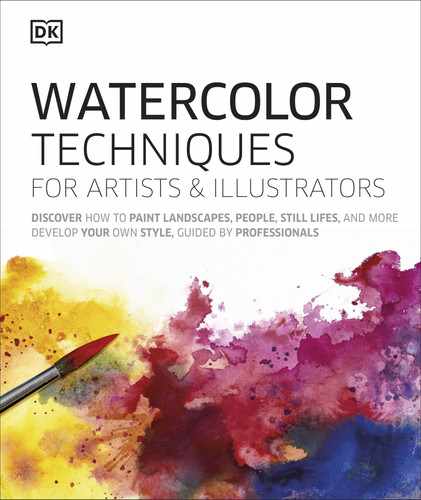
144 Advanced | TECHNIQUES
Scraping
SCRATCHING AT THE PAPER’S SURFACE
Scraping is a useful technique to remove
layers of color, create light shapes, and add
texture to a painting when a brush can’t do
the job. The best scraping tools—from old
credit cards and penknives to palette knives
and plastic spoons—have relatively at
edges. Judicious scraping is always called
for; don’t get carried away.
Judging when to scrape
When the wash is still damp, you can scrape out details
with your chosen tool. Paint removed from the paper’s
bers reveals the lighter area beneath. Paper types that
absorb more paint make it harder to lift out colors, and
some colors, such as phthalo blue, are more staining.
1
Prepare the paper
Draw out your composition on heavy
watercolor paper, then dampen evenly
with a large mop brush, keeping the
gures and rest of the foreground dry.
Buduruwagala, Sri Lanka
PUTTING IT INTO PRACTICE
Scraping back creates points of interest through
varied marks and is an effective way to suggest
texture, as shown in this painting of a stone
Buddha monument in Sri Lanka.
No. 10 and no. 000 soft-hair
mop brushes
Scraping tools, such as a cut-up
credit card as used here
Rubber scraper
16 x 12 in (40 x 30 cm)
cold press 300 lb (640 gsm)
watercolor paper
You will need
Wet or dry?
Move damp color with your chosen tool, scraping and rotating the
tool at the same time. If you try to move the paint when it is too wet,
pigment will creep back into the shape instead being lifted out; if the
paper is too dry, you won’t be able to scrape the paint away.
Staining pigment
Too dry
Scraped paint
Too wet
The paper is evenly damp
and ready for the paint
Cadmium red
Yellow ocher
Ultramarine
blue
Quinacridone
magenta
Neutral tint
Indanthrene
blue
Caput mortuum
violet
Manganese
blue
Pure yellow
US_144-145_Scraping-back.indd 144 02/04/2020 3:34pm

145 Scraping
2
The rst wash of color
Lay in a variegated wash of
yellows, oranges, and purples mixed
from indanthrene and quinacridone
magenta, letting the colors mix gently
on the paper. Leave the wash for a
minute before scraping—the paper must
have just the right amount of wetness.
3
Scrape shapes
Press hard into
the wash with the
edge of your tool and
pull or drag the paint
away—you want to
scrape and rotate the
tool at the same time.
If the paper feels too
wet, the paint will ll
back in, so leave it a
few minutes to dry
before you start.
4
Scrape details
When the rst
shapes are dry,
repeat the process
in smaller areas using
ner tools. Let the
paint soak in a little
before lifting out the
color, and wipe the
tool clean between
scrapes to prevent
color transfer.
5
Finishing
touches
Stand back to assess
the overall effect
and, if required,
nish any last details
with a small brush,
adding more local
color in the desired
areas, without
overworking them.
“You can scrape out
subtle details, lines,
and irregular shapes
with your tool
of choice.”
US_144-145_Scraping-back.indd 145 02/04/2020 3:34pm
..................Content has been hidden....................
You can't read the all page of ebook, please click here login for view all page.
